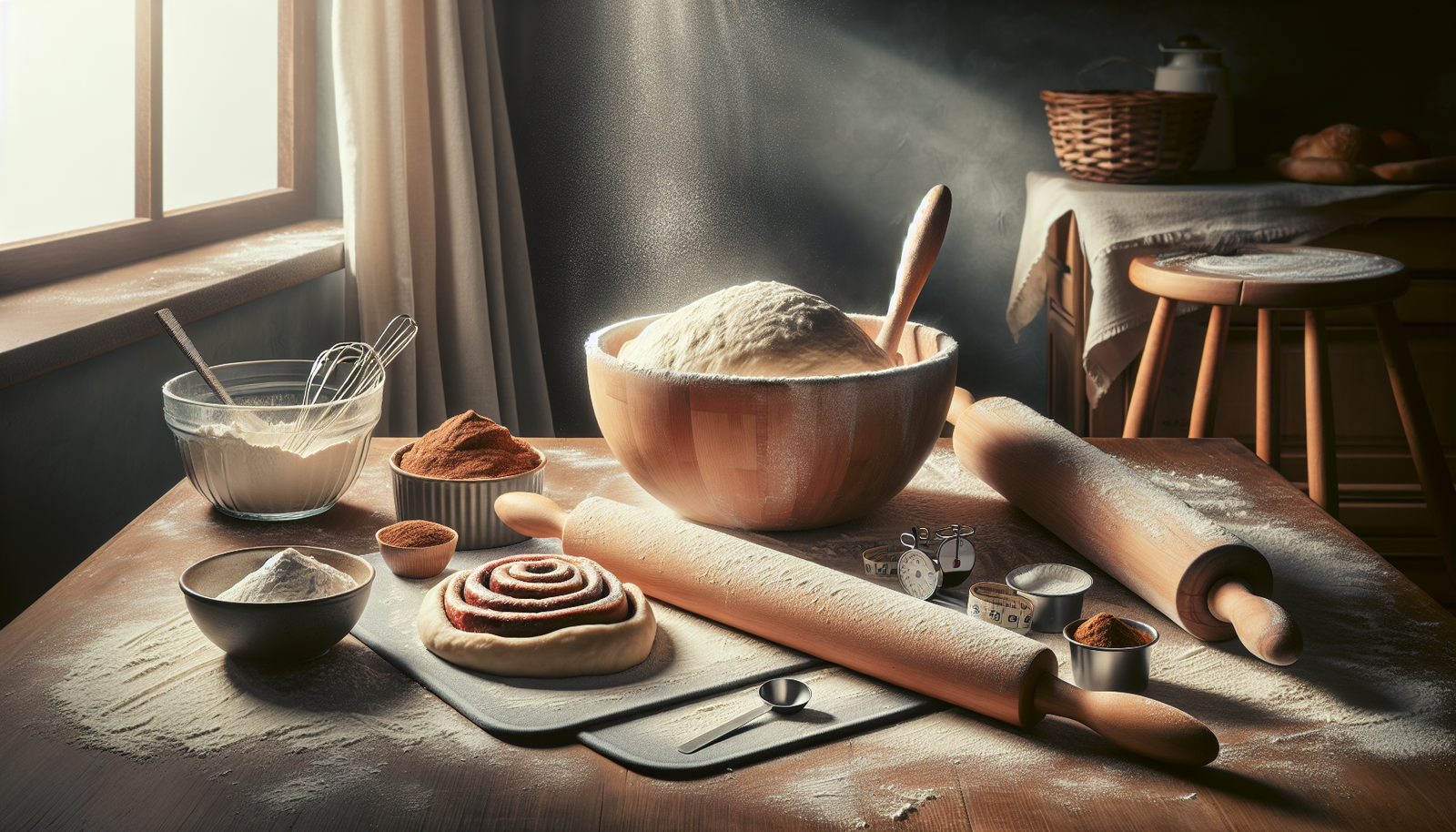
How to Make Dough for Homemade Cinnamon Rolls
make dough for cinnamon rolls to fill your kitchen with irresistible aromas that evoke comfort and warmth. Starting with a simple mix of basic ingredients, this guide will show you the vital steps to create perfect, fluffy cinnamon rolls. Rolling and filling them with sweet cinnamon sugar before baking to golden perfection will soon become your favorite kitchen ritual. Perfect for breakfast or a cozy afternoon treat, these homemade delights are sure to impress. Dive into the process, and let’s turn basic ingredients into a cherished family tradition.
## Preparing Ingredients for Cinnamon Roll Dough
Creating mouth-watering cinnamon rolls begins with a solid foundation: the dough. The right combination of ingredients can transform your cinnamon rolls from ordinary to extraordinary. Understanding what goes into this mix is crucial to achieving that perfect, fluffy texture. We’ll dive into the essentials, offer tips on selecting the best components, and highlight common pitfalls to avoid when measuring.
### Essential Ingredients for Perfect Cinnamon Roll Dough
To craft cinnamon roll dough that melts in your mouth, the choice of ingredients is vital. Here’s a breakdown of what you’ll need:
– **Flour**: Use all-purpose flour for a balance of strength and elasticity. It helps the dough hold its shape while being soft enough to yield a tender crumb.
– **Yeast**: Active dry yeast is ideal for cinnamon rolls, as it ensures consistent rising and a light texture. Instant yeast can also be used for a quicker rise.
– **Milk**: Whole milk provides richness and tenderness. Warm the milk slightly to help activate the yeast without killing it.
– **Sugar**: Granulated sugar sweetens the dough and aids in yeast activation. A touch of sugar enhances the flavor profile.
– **Butter**: Unsalted butter adds a rich, buttery flavor. Ensure it’s softened to blend smoothly with other ingredients.
– **Eggs**: Eggs enrich the dough, adding structure and moisture. They contribute to a soft, fluffy roll.
– **Salt**: A small amount of salt balances the sweetness and enhances the overall taste.
### Tips on Choosing the Best Ingredients for Dough
Selecting high-quality ingredients makes a significant difference in your cinnamon rolls’ outcome. Here’s how to choose wisely:
– **Flour**: Opt for unbleached, all-purpose flour for a more natural taste and better texture. Organic flour is another great option for those seeking a cleaner ingredient profile.
– **Yeast**: Check the expiration date on your yeast package. Fresh yeast is crucial for a proper rise. Store unopened yeast in a cool, dry place and refrigerate once opened.
– **Milk**: Choose whole milk for its richness. If you’re lactose intolerant, lactose-free whole milk or a rich plant-based milk like oat milk can work.
– **Butter**: Use unsalted butter to control the salt in your dough. High-quality, grass-fed butter imparts a superior flavor.
– **Eggs**: Free-range or organic eggs often have a richer yolk, enhancing both flavor and color.
– **Sugar and Salt**: Opt for granulated white sugar and fine sea salt for a consistent blend and smooth taste.
### Common Mistakes to Avoid When Measuring Dough Ingredients
Precision is key when measuring ingredients for cinnamon roll dough. Small errors can lead to significant changes in texture and taste. Here are some common pitfalls:
– **Incorrect Flour Measurement**: Use a kitchen scale for the most accurate measurement. If you don’t have one, aerate your flour with a spoon before scooping and level with a knife without packing it down.
– **Wrong Liquid Temperature**: Ensure milk is warm (around 110°F/43°C) to activate the yeast without damaging it. Too hot or too cold can prevent proper rising.
– **Using Expired Yeast**: Always check the yeast’s expiration date. Expired yeast can result in dense, flat rolls.
– **Overly Soft Butter**: Butter that’s too soft can lead to greasy dough. Aim for a soft yet firm consistency that holds its shape.
– **Ignoring Salt**: Adding no salt can make the dough taste flat. Measure carefully and don’t skip this ingredient.
Understanding these essential ingredients and their roles ensures a strong start to your cinnamon roll journey. With these tips, your dough will be set for success right from the beginning.
## Step-by-Step Guide to Making Cinnamon Roll Dough
Now that you’ve gathered the right ingredients, it’s time to transform them into a luscious dough. This step-by-step guide will lead you through the mixing, kneading, and proofing processes. Each stage is crucial in developing the dough’s flavor and texture, ensuring your cinnamon rolls are as soft and fluffy as they should be.
### Mixing the Dough: Achieving the Right Consistency
The mixing process is where the magic begins. It’s essential to combine your ingredients correctly to create a dough that’s smooth and elastic.
1. **Combine Dry Ingredients**: Start by whisking together flour, yeast, sugar, and salt in a large mixing bowl. Ensure these dry components are evenly distributed.
2. **Incorporate Wet Ingredients**: In a separate bowl, whisk the eggs and warm milk together. Add the softened butter and mix until smooth.
3. **Mix Together**: Gradually add the wet ingredients to the dry ingredients, stirring with a wooden spoon or using a stand mixer with a dough hook attachment. Mix until a shaggy dough forms.
4. **Adjust Consistency**: If the dough feels too sticky, add more flour, one tablespoon at a time. If it’s too dry, add milk in small increments.
5. **Smooth Finish**: Continue mixing until the dough pulls away from the sides of the bowl and forms a soft, slightly sticky mass. The dough should be elastic but not cling to your hands.
Achieving the right consistency during mixing is critical. This step determines how well the dough will rise and its final texture.
### Kneading the Dough for Optimal Texture
Kneading develops the dough’s gluten structure, contributing to its chewy texture and rise.
1. **Prepare Your Surface**: Lightly flour a clean work surface. Transfer the dough from the bowl onto this area.
2. **Knead with Purpose**: Use the heel of your hand to push the dough away from you, then fold it back over itself. Rotate and repeat this process rhythmically.
3. **Texture Check**: Knead the dough for about 8-10 minutes. It should become smooth and elastic, bouncing back when poked gently.
4. **Avoid Over-Kneading**: Be careful not to over-knead, as this can make the dough tough. Stop when you achieve a soft, stretchy texture.
5. **Rest the Dough**: Once kneaded, shape the dough into a ball, and let it rest for about five minutes. This helps relax the gluten and makes it easier to roll out later.
Proper kneading sets the stage for perfect cinnamon rolls. This step ensures a tender yet sturdy structure that holds the filling well.
### Proofing Dough: How Long to Let Cinnamon Roll Dough Rise
Proofing is a critical phase where the dough develops flavor and doubles in size.
1. **First Rise**: Place the kneaded dough in a greased bowl. Cover it with a damp cloth or plastic wrap.
2. **Ideal Temperature**: Let the dough rise in a warm, draft-free area. The temperature should be around 75°F (24°C) for optimal rising.
3. **Time It Right**: Allow the dough to rise for 1 to 2 hours, or until it doubles in size. Rising time can vary based on the room temperature and yeast activity.
4. **Visual Check**: The dough should appear puffed and airy. A gentle poke with a finger should leave an indentation that slowly springs back.
5. **Second Proof**: After shaping the cinnamon rolls, allow them to rise again for about 30-45 minutes before baking. This ensures a light, fluffy finish.
Proofing is essential for flavor development and texture. Patience during this stage results in cinnamon rolls that are worth the wait.
## Expert Tips for Perfectly Fluffy Cinnamon Roll Dough
Having mastered the basics, it’s time to refine your technique with expert tips. These insights will help you adapt your dough to different conditions, store it for future use, and troubleshoot any issues you might encounter. With these tips, your cinnamon rolls will be consistently delightful and perfectly fluffy every time.
### Adjusting Dough for Different Baking Conditions
When baking in varying environments, slight adjustments can make a big difference in the dough’s outcome.
– **High Altitude**: At higher altitudes, reduced air pressure can affect rising. Reduce yeast by about 25% and increase liquid slightly to prevent the dough from drying out.
– **Humidity Levels**: In humid environments, flour can absorb moisture. Use slightly less liquid or more flour to achieve the right dough consistency.
– **Cold Kitchens**: In a cooler kitchen, dough might rise slowly. Use a warm oven with the light on as a makeshift proofing box or increase rise time.
– **Warm Climates**: If it’s too warm, the dough might over-proof quickly. Shorten the rise time and refrigerate the dough if needed to slow yeast activity.
### Storing Cinnamon Roll Dough for Later Use
Sometimes, you may want to prepare dough ahead of time. Proper storage ensures it remains fresh and ready to bake when needed.
– **Refrigeration**: After the first rise, punch down the dough and store it in an airtight container. Refrigerate for up to 24 hours. Bring to room temperature before shaping and baking.
– **Freezing**: For longer storage, freeze the dough after shaping the rolls but before the second rise. Wrap tightly in plastic wrap and a layer of aluminum foil, then freeze for up to a month.
– **Thawing and Baking**: Thaw frozen rolls overnight in the refrigerator. Let them come to room temperature and complete the second rise before baking.
### Troubleshooting Common Dough Issues
Even the best bakers encounter issues. Here are solutions to some common dough problems:
– **Dough Isn’t Rising**: Check yeast freshness and ensure the proofing area is warm enough. If yeast is inactive, consider starting over with fresh yeast.
– **Dough Too Sticky**: Gradually add flour until the desired consistency is reached. Knead in additional flour little by little to avoid over-drying.
– **Dough Rising Too Fast**: Punch down the dough to release air and slow the proofing process. Place in a cooler area to
Conclusion
To make dough for cinnamon rolls, start by combining warm milk, yeast, and sugar, allowing the mixture to become frothy. Add in flour, salt, eggs, and melted butter, mixing until a soft dough forms. Knead the dough until it is smooth and elastic, then let it rise in a warm place until doubled in size. After rising, roll the dough out into a rectangle and spread with butter, sugar, and cinnamon before rolling it tightly. Cut into individual rolls and let them rise again before baking until golden brown.
“`html
FAQ
What are the essential ingredients needed for making cinnamon roll dough?
For a fluffy and flavorful cinnamon roll dough, you’ll need all-purpose flour, sugar, salt, eggs, milk, butter, and yeast. These ingredients form the perfect base for soft, delectable rolls.
How long should I let my cinnamon roll dough rise before baking?
The dough should rise until it doubles in size, generally taking about 1 to 2 hours. A warm, draft-free environment speeds up this process and ensures a fluffy texture.
What is the best type of yeast to use for homemade cinnamon rolls?
Active dry yeast and instant yeast both work well for cinnamon rolls. Instant yeast rises faster, while active dry yeast offers a richer flavor. Choose based on your preference and time constraints.
Can I make cinnamon roll dough ahead of time and refrigerate it?
Yes, you can prepare the dough in advance. Let it rise once, then refrigerate it. This enhances the flavor and allows you to bake fresh rolls the following day.
How do I know if my cinnamon roll dough is kneaded enough?
The dough should be smooth and elastic after kneading. A simple test is to stretch it gently; it should form a thin “windowpane” without tearing, indicating proper gluten development.
What are the common mistakes to avoid when preparing cinnamon roll dough?
Avoid adding too much flour, which can lead to dry rolls. Ensure the yeast is fresh and not expired, and be cautious of water temperature; too hot can kill the yeast, while too cold can slow fermentation.
“`











